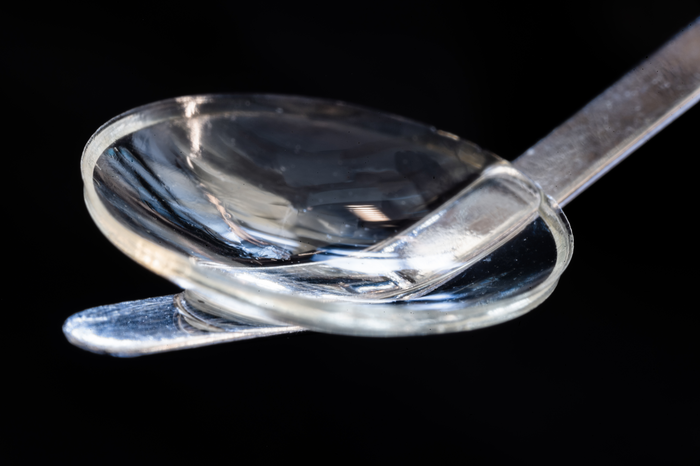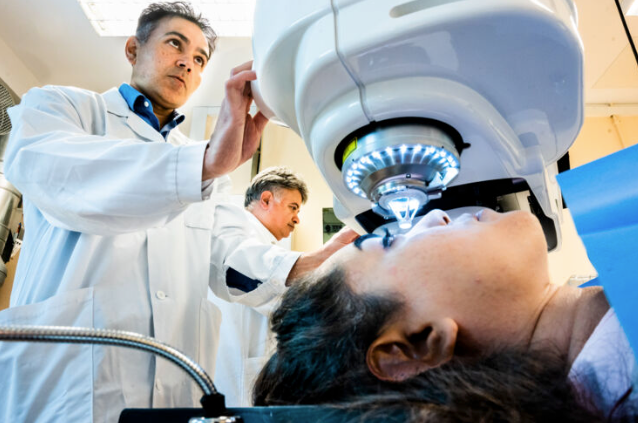Article
Bioengineered cornea can restore sight to the blind and visually impaired
Author(s):
Researchers at Linköping University have used implants made from pig skin to restore sight to 20 people with diseased corneas.
Cornea implant made of collagen protein from pig’s skin. (Image courtesy of Thor Balkhed/Linköping University)

A team of researchers at Linköping University (LiU) has restored the vision of 20 volunteers in a pilot study that used a cornea implant made out of collagen gathered from pig skin. Pending further testing, the novel bioengineered implant may help ophthalmologists improve the vision of millions of patients around the world awaiting difficult and costly cornea transplant surgeries.
Researchers and entrepreneurs have developed an implant made of collagen protein from pig’s skin, which resembles the human cornea. In a pilot study, the implant restored vision to 20 people with diseased corneas, most of whom were blind prior to receiving the implant.
The study1 jointly led by researchers at LiU and LinkoCare Life Sciences AB has been published in Nature Biotechnology. The promising results bring hope to those suffering from corneal blindness and low vision by providing a bioengineered implant as an alternative to the transplantation of donated human corneas, which are scarce in countries where the need for them is greatest.
“The results show that it is possible to develop a biomaterial that meets all the criteria for being used as human implants, which can be mass-produced and stored up to two years and thereby reach even more people with vision problems,” said Neil S. Lagali, a professor at the Department of Biomedical and Clinical Sciences at LiU, one of the researchers behind the study. “This gets us around the problem of shortage of donated corneal tissue and access to other treatments for eye diseases.”
According to a news release from Linköping University, an estimated 12.7 million people around the world are blind due to their corneas, which is the outermost transparent layer of the eye, being damaged or diseased. A corneal transplant may be the only way for these patients to regain vision, and that requires a human donor. The university noted that just 1 in 70 patients receives a cornea transplant. Furthermore, most of those who need cornea transplants live in low and middle-income countries in which access to treatments is very limited.
The researchers have developed a new, minimally invasive method. A small incision is made, through which the implant is inserted into the existing cornea. The incision can be made with an advanced laser (as in the photo), but also, when needed, by hand with simple surgical instruments. (Image courtesy of Thor Balkhed/Linköping University)

“Safety and effectiveness of the bioengineered implants have been the core of our work, said Mehrdad Rafat, the researcher and entrepreneur behind the design and development of the implants. He is an adjunct associate professor (senior lecturer) at LiU’s Department of Biomedical Engineering and founder and CEO of the company LinkoCare Life Sciences AB, which manufactures the bioengineered corneas used in the study.
“We have made significant efforts to ensure that our invention will be widely available and affordable by all and not just by the wealthy,” he explained. “That is why this technology can be used in all parts of the world.”
The cornea consists mainly of the protein collagen. To create an alternative to human cornea, the university noted that the researchers used collagen molecules derived from pig skin that were highly purified and produced under strict conditions for human use. The pig skin used is a byproduct of the food industry, making it easy to access and economically advantageous. In the process of constructing the implant, the researchers stabilized the loose collagen molecules forming a robust and transparent material that could withstand handling and implantation in the eye. While donated corneas must be used within two weeks, the bioengineered corneas can be stored for up to two years before use.
The university also noted that the researchers have developed a new, minimally invasive method for treating the disease keratoconus, in which the cornea becomes so thin that it can lead to blindness. Today, a keratoconus patient’s cornea at advanced stage is surgically removed and replaced by a donated cornea, which is sewn into place using surgical sutures. This kind of surgery is invasive and only done at larger university hospitals.
Lagali noted in the news release that a less invasive method could be used in more hospitals, thereby helping more people.
“With our method, the surgeon doesn’t need to remove the patient’s own tissue,” he explained. “Instead, a small incision is made, through which the implant is inserted into the existing cornea.”,
Lagali, according to the university, has led the research group that has developed this surgical method.
Moreover, the university noted that no stitches are needed with this new surgical method. The incision in the cornea can be made with high precision thanks to an advanced laser, but also, when needed, by hand with simple surgical instruments. The method was first tested on pigs and turned out to be simpler and potentially safer than a conventional cornea transplant.
The surgical method and the implants were used by surgeons in Iran and India, two countries where many people suffer from corneal blindness and low vision, but where there is a significant lack of donated corneas and treatment options.
According to the university’s news release, 20 people who were either blind or on the verge of losing sight due to advanced keratoconus participated in the pilot clinical study and received the biomaterial implant. The operations were free from complications; the tissue healed fast; and an 8-week treatment with immunosuppressive eye drops was enough to prevent rejection of the implant. With conventional cornea transplants, medicine must be taken for several years. The patients were followed for 2 years, and no complications were noted during that time.
The primary purpose of the pilot clinical study was to investigate whether the implant was safe to use. However, the researchers were surprised by what happened with the implant. The cornea’s thickness and curvature were restored to normal. At the group level, the participants’ sight improved as much as it would have after a cornea transplant with donated tissue. Before the operation, 14 of the 20 participants were blind. After two years, none of them was blind any more. Three of the Indian participants who had been blind prior to the study had perfect (20/20) vision after the operation.
A larger clinical study followed by market approval by regulatory authorities is needed before the implant can be used in healthcare. The researchers also want to study whether the technology can be used to treat more eye diseases, and whether the implant can be adapted to the individual for even greater efficacy.
LinkoCare Life Sciences AB, which is responsible for the production, certification, packaging, and sterilisation of the implants used in the study, with the support of Care Group India, covered the cost of implant manufacturing, ISO-compliant preclinical testing, and clinical testing.
Further funding for the study for biomaterials and surgical development and testing came from the European Union Horizon 2020 Program, and ALF funds from Linköping University and the Östergötland Region. These funders did not participate in the design or execution of the research. Mehrdad Rafat is the patent holder, via LinkoCare AB, and sits on the company’s board. Another of the study's co-authors (Shideh Tabe) also sits on the company’s board.
Neil S. Lagali
Lagali has no financial disclosures related to this content.
Reference
1. Mehrad Rafat; Mahmoud Jabbarva; Namrate Sharma; Maria Xeroudaki; Shideh Tabe; Raha Omrani; Muthukumar Thangavelu; Anthony Mukwaya; Per Fagerholm; Anton Lennikov; Farshad Askarizadeh; Neil Lagali; Bioengineered corneal tissue for minimally invasive vision restoration in advanced keratoconus in two clinical cohorts. Nature Biotechnology; published Aug. 11, 2020; accessed Aug. 13, 2020. DOI: 10.1038/s41587-022-01408-w
Newsletter
Don’t miss out—get Ophthalmology Times updates on the latest clinical advancements and expert interviews, straight to your inbox.





